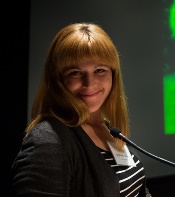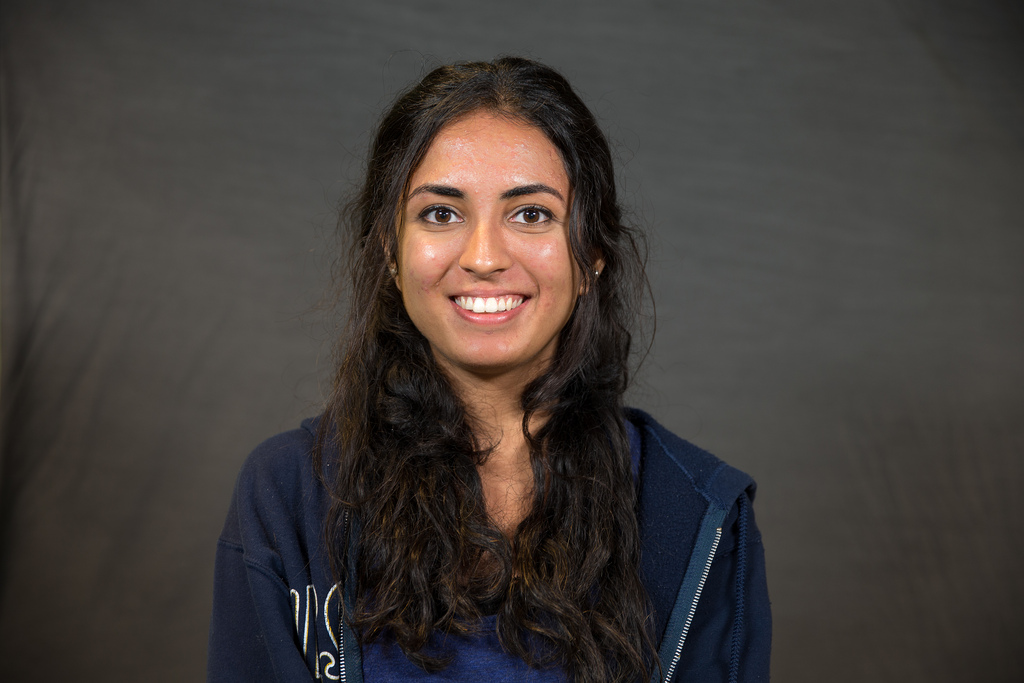QI Undergraduate Research Scholars Cap off Summer with Posters and Presentations
By Tiffany Fox, (858) 246-0353, tfox@ucsd.edu
San Diego, Calif., Oct. 3, 2013 — The University of California, San Diego’s Qualcomm Institute has state-of-the art data visualization facilities, cutting-edge laboratories and even a large, open space for high-tech yoga classes. Practically the only thing it doesn’t offer is room and board — and that’s something that might come in handy for Computer Science and Engineering undergraduate Stephanie Conley.
|
Conley has become something of a mainstay at the QI headquarters in Atkinson Hall. She's worked as a part-time student tour guide for the Qualcomm Institute for going on a year, and even elected to spend her summer break at the institute as a QI Summer Undergraduate Research Scholar. Conley was one of 29 students who participated in the program for 10 weeks this summer, and was recruited by CSE Professor Vineet Bafna to work in his lab developing a cost-effective device known as a turbidostat to keep algael cultures healthy.
Conley and her fellow participants in the “Summer Scholars” program gave the rest of the QI and UC San Diego community a peek into their research endeavors last week at an event that combined a series of short oral presentations with a poster session in the lobby of Atkinson Hall — one of the first opportunities many students had to formally present academic research.
“I came to the Qualcomm Institute because I really like the innovation and research that goes on here,” Conley said during the poster session. She says her research project with Prof. Bafna, which has important implications for the development of algae biofuels, stemmed from a course she took in CSE 145 (Embedded System Design Project) which is taught by QI affiliate Research Scientist Albert Yu-Min Lin and Principal Development Engineer Curt Schurgers. Once she found out about the wide array of collaborative projects going on under the roof of Atkinson Hall, “I knew I had to be a part of that.”
Through the Summer Scholars program, Conley helped design an app for a turbidostat, a device equipped with photo sensors and a microcontroller to measure the turbidity or ‘cloudiness’ of algae cultures. The app charts the data from the turbidostat in real time to determine if algae samples are surviving.
“Cloudy is good,” explained Conley. “It means the algae are flourishing. But if they aren’t flourishing, the turbidostat has a solenoid valve that opens and closes to let in nutrients or flush the algae. With the app, we can do that remotely.”
Conley said that it costs a single-sample bioreactor $8,000 to do what she and her team can do with their turbidostat array for only $500. And their device can measure six samples at a time. That’s a 94 percent cut in costs, which is a boon for the emerging field of algae biofuels.
“We can exploit the algae’s physiology to do other things, too,” she continued. “There are a lot of medical applications — scientists use genetically engineered algae to create cancer drugs and antimalarial vaccines, for example.”
Conley was one of five undergraduates selected to present her research before fellow QI students, staff and faculty. Other presenters included Biophysics major Jonathan Hasselmann (“ACPPs Induce Tumor Cell Death”); NanoEngineering and Electrical Engineering major Cory Heath (“A Novel Patch-Clamp Platform for Parallel and Massive Cell Potential Measurements”); Environmental Systems major Sarah Schwartz (“Aging and Cellular Mitigation of Damage in Both Individual Organisms and Evolving Populations”); and Microbiology Major Rebecca Stanhope (“Evolving Resistance to Malaria”).
|
Twenty-four additional students presented self-designed research posters following the talks, including Cognitive Science major Akila Kadambi, who spent the summer working with QI-affiliated Associate Professor Ayse Saygin to analyze the “Unconscious Processing of Animate Motion” among human subjects.
The team wanted to know if the human brain activates when someone sees motion unconsciously, so they created an experiment that used a graphic representation of a human walking that consisted of pinpoints of light. In some trials, the walker was clearly visible, making it easier for the test subject to determine which direction it was moving. In other trials, the walker was obstructed by a visual ‘noise’ cloud.
“We wanted to see if the subjects’ reaction time was affected by the noise cloud,” explained Kadambi. “What we found was an adaptation effect. When the direction of the walker changed, the subjects’ reaction times sped up. What this suggests is that your neurons get ‘tired’ from seeing the same image over and over, so when the image changes, your neurons start to fire more quickly and therefore you react more quickly.”
Kadambi noted that the results could be important for understanding the way that individuals with autism process animate motion, and also for understanding how to best design robots to overcome the “uncanny valley” hypothesis, which states that when a robot’s features or movements are almost, but not exactly, like a human’s, human observers can react with revulsion.
“We’re now looking at whether the form or the motion of the robot is more important in terms of overcoming the uncanny valley,” added Kadambi.
Now that the summer has ended and the academic year has started up again, Kadambi, Conley and the other Summer Scholars are back in class. But Conley can still be found wandering the floors of Atkinson Hall as a tour guide. Just today she was doing demos for participants in The Atlantic Meets the Pacific conference, some of whom are using algal cultures to develop the pharmaceuticals of the future. Who knows — the turbidostat array Conley worked on just might turn up in one of their labs one day.
Media Contacts
Tiffany Fox, (858) 246-0353, tfox@ucsd.edu
Related Links



